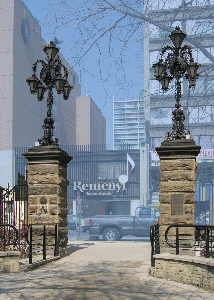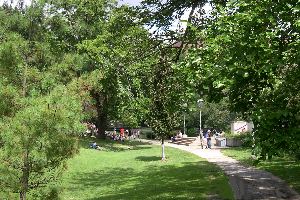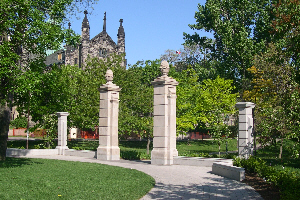
Walking west from Avenue Road along the south side of Bloor Street, just west of the Royal Ontario Museum one finds an elaborate structure with stone pillars and serpent-headed, wrought iron lamps. This is the Queen Alexandra Gateway, which now marks the north end of Philosopher’s Walk. This imposing bit of Edwardian fantasy is equal to any you might find in such places as London or Paris. Plaques on both the north and south sides tell us that the gate was built “To commemorate the visit of TRH the Duke & Duchess of Cornwall & York Oct. 10th 1901.” The Duke and Duchess are better know by their later titles King George V & Queen Mary. Queen Alexandra was the Duke’s mother and had just become Queen, as her husband, Edward VII had succeeded his mother Queen Victoria earlier that year.
The Duke and Duchess had been out west and arrived in Toronto at a station on Dupont Street. As a future King and Queen they were met by cheering crowds all along the way, despite a cold October rain. Toronto was quite a different city a century ago. Rather than a multicultural metropolis bustling with people from all parts of the world, it was a very British colonial city. The Mail and Empire, in telling about how the city welcomed its future sovereign and his wife, said “To Toronto belongs the glory of the very climax of Canada’s welcome to the heir-apparent. And why not to Toronto - loyal Toronto - the heart of English-speaking Canada, the great centre of imperial impulse, and first among cities of Greater Britain in devotion to the British flag and the British Crown.” Canadians really did think of themselves as British. It was only later in the century, that we began to consider ourselves Canadians first.
The Daughters of the Empire (later the Imperial Order of Daughters of the Empire, IODE), which had financed the building of the gate, decorated it with flowers, evergreens and ribbons and had stands for spectators built on the SE and SW corners. When the ducal carriage stopped at Avenue Road opposite the Alexandra Gate “two little girls dressed in white frocks and white hats with long ostrich plumes, came forward carrying the ends of broad white silk ribbons, the other ends of which were attached to the leaves of the gate. – These little tots were, at the invitation of Her Royal Highness, lifted into the carriage and placed the ends of the ribbons into her hands. Her Royal Highness then pulled the long ribbons bands and the gates slowly opened allowing another dainty maiden – to come forward with a bouquet of red and yellow roses(the Duke’s colours). — Though it was raining pretty steadily, this unique and pretty ceremony was carried out entirely as planned.” Mail and Empire.
A commemorative plaque attached to the western pillar tells us that the gate was moved from its original location at the Bloor Street end of Queen’s Park in 1962 and that the wrought iron lamps were restored in 1990 as a special project by the staff of the University’s Facilities and Services Department.
“Queen Alexandra Gateway
“This stone and wrought iron structure was a gift to The Imperial Order Daughters of The Empire to commemorate the visit on October 10 and 11, 1901, of Their Royal Highnesses, the Duke and Duchess of Cornwall and York.
“The gateway, designed by Chadwick and Buckett, architects, originally stood on Bloor Street at the north entrance to Queen’s Park. It had to be moved twice to accommodate transportation improvements and was eventually located here 1962 . The wrought iron lamps were restored in1990 as a special project by the staff of the Faculties and Services Department of the University of Toronto.
“The University of Toronto fully restored the Gateway and the southward extension of Philosopher’s Walk extending southward in 1995. a rededication ceremony was held on October 14 1995.”

Along Philosopher’s Walk
In the spring of 2006, at the south end of Philosopher’s Walk, a new “gate” was constructed in honour of Avie Bennett, the owner of McClelland & Stewart, the Toronto publishing firm that gave us many Canadian literary masterpieces. In 2000, he had donated 75-per-cent ownership of his firm to the University of Toronto.

